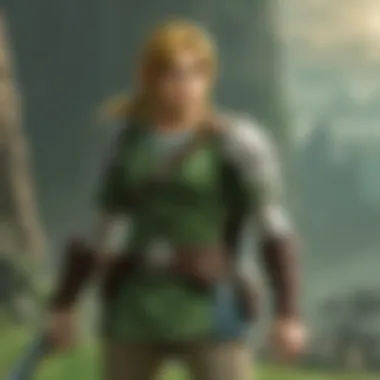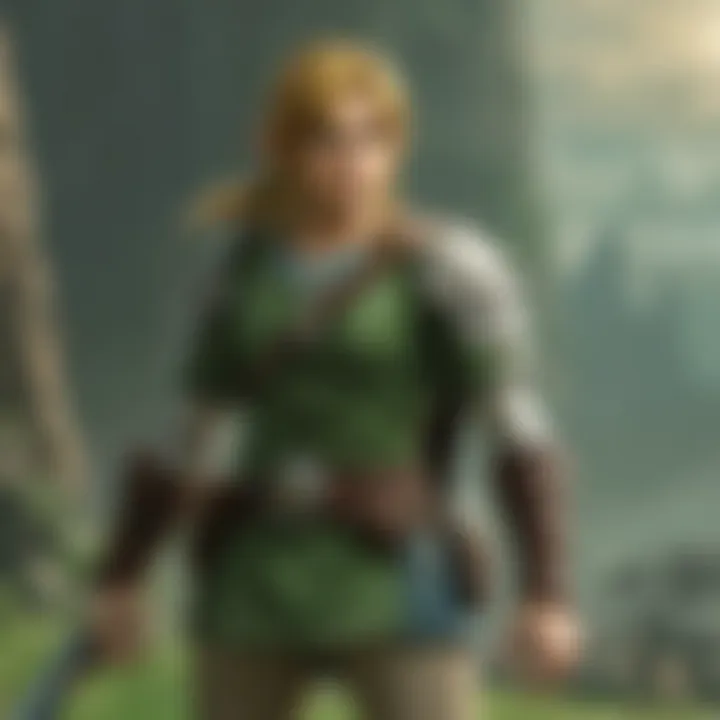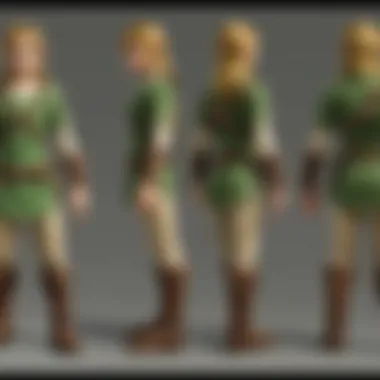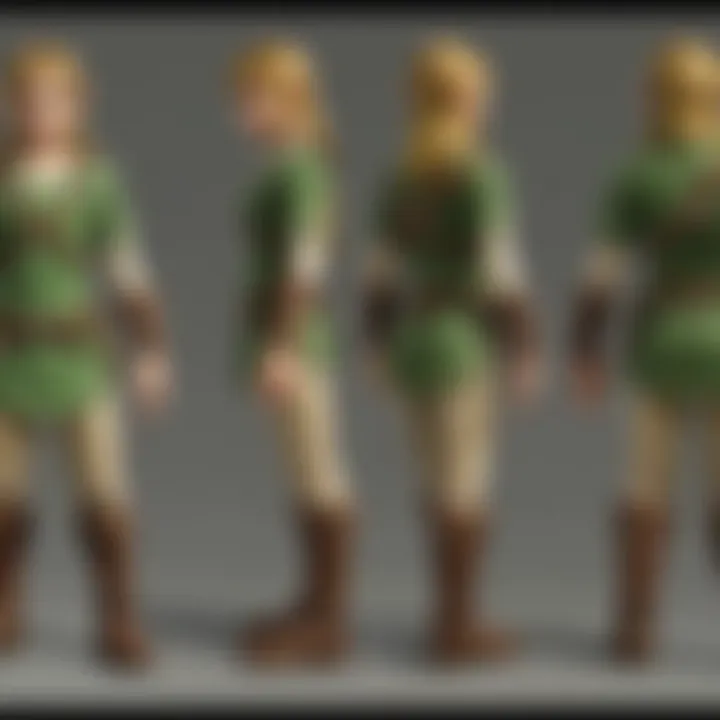Analyzing Gameplay Time in the Zelda Franchise


Intro
The Zelda series, a pillar in the realm of video games, encapsulates an elaborate journey that transcends the mere act of playing. Fans often ponder the significant role that gameplay time plays in shaping their experience. With each title presenting its unique mechanics and storytelling, understanding how time influences these elements can enhance one's appreciation of the franchise. This exploration encompasses various aspects of the game — the gripping main quests, the allure of side quests, and the subtle strategies employed by players, which ultimately frame the narrative fabric of this iconic series.
As we embark on this journey, we will analyze the impact of gameplay mechanics on the time invested in various Zelda titles. The ways in which dedicated players engage differently than casual ones will surface as a focal point, alongside the deeper implications this has on their overall enjoyment. Let’s delve into it, step by step, unlocking layers of the Zelda experience that often go unnoticed.
Understanding Gameplay Time
In the enchanting world of the Zelda series, the concept of gameplay time isn’t just about the hours logged in front of a screen. It captures the essence of player engagement and defines the depth of the experience within these fantastical realms. The Zelda franchise, known for its rich narrative and intricate world-building, presents unique challenges and quests that invite players to immerse themselves fully. Understanding gameplay time in this context can significantly shape how fans interact with the series.
The exploration of gameplay time involves understanding various key components that lead to a richer gaming experience. First and foremost, it encompasses the duration players spend within the game, including time taken on main quests, side quests, and exploration. The difference in gameplay time creates a split between casual gamers, who may breeze through the main storyline, and dedicated fans, who strive for completion and seek to uncover every hidden secret.
Measuring how much time players invest not only helps in evaluating game design but also reflects on the playing habits across different demographics. With each new title, the Zelda franchise has undergone transformations, each impacting the overall gameplay experience. Players often bring their own skill levels and familiarity with the series into play, resulting in varied gameplay times.
By dissecting the elements that comprise gameplay time, this article aims to provide a nuanced understanding of what makes the Zelda experience so engaging and memorable. The following sections will dive deeper into the definitions, significance, and historical context, paving a path to appreciate how gameplay time serves as a lens through which the world of Zelda can be explored.
Definition of Gameplay Time
When we talk about gameplay time, we're looking at the total amount of time spent by players engaging with a game, from the moment they power it up to the end credits. In the case of Zelda, this encompasses not just the main storyline, but also the plethora of puzzles, side quests, and exploration that players might undertake.
It’s important to recognize that gameplay time isn’t a one-size-fits-all concept. For instance, The Legend of Zelda: Breath of the Wild invites players to wander through vast landscapes, with each nook and cranny holding potential for discovery. Therefore, a player focused solely on completing the main quest may clock in fewer hours compared to one who revels in exploring every potentiality the game has to offer.
The variation in gameplay time reflects not only the design of the game but also the engagement style of the player. Some players may apply strategic approaches, while others might find themselves caught up in the narrative or environmental beauty. This unique interaction contributes to the individuality of each player's journey through Hyrule.
Importance of Measuring Gameplay Time
Measuring gameplay time is imperative for several reasons. First, it offers insight into the game design itself. Developers can analyze where players tend to spend the most time and refine mechanics based on that feedback. If players are consistently engaged in a specific area, that may indicate its success or potential as a future feature.
Furthermore, knowing the average gameplay times can help players set realistic expectations. In a world filled with busy schedules, understanding how long it might take to complete a game can inform purchasing decisions. Casual fans may want to know whether they can jump in and experience the story within a manageable time frame.
"Gameplay time isn’t a mere statistic; it is a reflection of player investment and connection to the universe crafted by the developers."
Lastly, measuring gameplay time fosters community discussions. Players often share their experiences on platforms like Reddit or Facebook, comparing completion rates and strategies, which enriches the communal understanding of the Zelda series.
In essence, analyzing gameplay time not only enhances the overall narrative around each title but also ensures that the franchise continues evolving in a way that resonates with its audience.
Historical Overview of Gameplay Duration in Zelda
Understanding the historical context of gameplay duration in the Zelda series sheds light on how players experience each title. By dissecting the time investment across generations of games, you get a clearer picture of the evolution of game design and player engagement. Different eras in gaming ushered in various expectations on how long a player might be immersed within Hyrule, and these changes influenced not just gameplay but also the storytelling and player satisfaction found in each release.
Early Titles: A Comparison
The inception of the Zelda series began in 1986 with the release of The Legend of Zelda on the Nintendo Entertainment System. This game introduced players to a vast world packed with secrets, challenges, and a nonlinear approach to gameplay. Players could spend anywhere from 8 to 15 hours on a single playthrough, depending on how methodical they were in exploring. The original title was innovative, focusing on exploration rather than a fixed pathway. The gameplay experience here leaned heavily on curiosity fuelled by a sense of discovery, rather than lengthy gameplay duration.
In juxtaposition, Zelda II: The Adventure of Link continued the same spirit but pivoted toward a more linear structure with RPG elements. This shift saw gameplay times averaging around 12-20 hours. While this was still a manageable time commitment, the gaming community began to feel the weight of these longer quests, preferring the exploration aspect from the earlier title.
Both titles laid foundational stones for player expectations, but they also foreshadowed the various adaptations in gameplay length to come.
Modern Releases and Their Length
Fast forward to the modern era, particularly with titles like The Legend of Zelda: Breath of the Wild, released in 2017, and the difference is striking. Here, gameplay duration can easily stretch well beyond 50 hours if a player aims to fully realize the world crafted by Nintendo. The blend of main quests, side quests, and the sheer enormity of the game world creates an immersive experience that encourages extended playtime. In this context, exploring every nook and cranny feels not just rewarding but essential to understanding Hyrule.
In contrast, The Legend of Zelda: Ocarina of Time—a classic released in 1998—provides a narrative brevity, averaging around 26-40 hours. While many see it as a compact experience, the inclusion of a rich story coupled with some of the most memorable gameplay moments contributes significantly to player retention.
"The true beauty of the Zelda series lies not just in its gameplay duration but in how it marries time spent with storytelling and player agency." - Anonymous


This historical overview not only informs players about gameplay times but also invites reflections on their own experiences and expectations from the series, making it a relevant topic for discussion among fans of all ages.
Factors Influencing Gameplay Time
When individuals pick up a game in the Zelda series, they often find themselves enveloped in a world full of adventure, secrets, and lore. Understanding how gameplay time is influenced can inform expectations and enhance the overall experience. Several elements, from quest structures to player skill levels, come into play, each carving its niche in the broader gameplay landscape.
Quest Structure and Design
Main Quests vs. Side Quests
In the Zelda titles, the distinction between main quests and side quests is a pivotal factor in influencing gameplay time. Main quests typically advance the storyline and surround the essential plot points. They are straightforward, like steering a ship down a well-marked channel. Side quests, in contrast, are akin to navigating a flowing river with hidden eddies and whirlpools, offering diverse experiences that can dramatically affect how long players spend in the game.
The strong characteristic of main quests lies in their structured design. They provide a clear path towards completing the game, allowing players to grasp the objectives easily. This makes it an efficient choice for players looking to finish the game in a set timeframe. However, diving into side quests introduces players to the richness of the game world, unveiling stories and characters often left untouched in main plots.
A unique feature of side quests is how they often require intricate tasks or exploration, which can lead to extended gameplay experiences. Players may find themselves engrossed in collecting rare items or solving elaborate puzzles, which can stretch gameplay hours beyond initial estimates. Given their depth, side quests are both a boon and a challenge, possibly leading to a longer but rewarding gameplay journey.
World-Building Elements
World-building elements in Zelda games significantly contribute to the overall gameplay time. Each title fabricates a unique environment that encourages exploration and curiosity. This sense of discovery is a vital characteristic of the franchise, drawing players into landscapes brimming with secrets. Players often feel the urge to uncover every nook and cranny to appreciate the world fully.
These world-building elements are beneficial for gameplay time as they promote exploration and interaction. Unlike a linear story, players can meander through lush forests, scale towering mountains, or delve into forgotten temples. The degree of interactivity within these environments is vast, offering puzzles, enemy encounters, and collectible items, all of which can add hours to the overall gameplay.
However, an important disadvantage of an expansive world is the risk of overwhelming players, especially newcomers. The sheer scale can dissuade them from engaging deeply, leading to shorter gameplay times. Striking a balance between a richly built world and ensuring accessibility for varied player skill levels is crucial for optimizing gameplay experience.
Player Skill Level
Casual vs. Dedicated Players
The player’s skill level directly impacts gameplay time in the Zelda series. Casual players may quickly maneuver through the main quests, perhaps skimming the surface of side quests or skipping them entirely in favor of finishing the game. On the other hand, dedicated players often dive headfirst into every challenge the game offers, investing time to master combat and refine their exploration techniques.
The contrast between these two player types encapsulates a key characteristic of audience engagement. Casual players tend to prefer a more streamlined experience, driven by story and immediate goals, making them less prone to extensive gameplay. In contrast, dedicated players, motivated by achievements and mastery, often seek to discover and accomplish every task in the game.
By understanding this distinction, developers can craft experiences that appeal to both demographics, ensuring that casual players aren’t alienated by complexity, while simultaneously feeding the enthusiasm of dedicated players.
Previous Experience with the Franchise
A player's previous experience with the Zelda franchise also plays a significant role in affecting gameplay time. For those seasoned in the mechanics and nuances of Zelda games, moving through quests feels second nature, similar to riding a bicycle. Conversely, new players might face challenges when acquainted with gameplay dynamics, which can elongate their journey.
The importance of prior experience lies in the foundation it builds for players. Familiarity with in-game mechanics, such as the importance of timing in combat or navigating puzzles, can drastically alter gameplay engagement. Players who understand previous titles, such as "The Legend of Zelda: Ocarina of Time," might find themselves more equipped to tackle challenges effectively, thus influencing their overall gameplay time.
However, a unique aspect is that new players often spend considerable time learning the ropes. This can be advantageous since it allows them to enjoy the intricacies of the game but can also be a disadvantage as they may feel perpetually behind, which could lead to dissatisfaction.
In summary, understanding the various factors that influence gameplay time in the Zelda series enables gamers to tailor their experiences, whether they are racing through dungeons or savoring each moment of exploration.
Gameplay Mechanics Impacting Time
The gameplay mechanics of the Zelda series play a pivotal role in shaping how long players engage with each title. Unlike mere filler content, these mechanics interweave the experience, enhancing both the time spent playing and the depth of interaction within the games. From combat systems to exploration methods, every aspect contributes to gameplay duration and player enjoyment. By understanding these mechanisms, we not only get insight into player behavior but also see how these elements impact long-term engagement and replay value.
Combat Mechanics
Combat mechanics in Zelda games are crucial in determining the pacing and duration of gameplay. The evolution of these mechanics—from simple swordfighting in the earlier titles to the complex, multi-layered systems found in Breath of the Wild—marks a significant shift in player engagement. Combat not only serves to challenge players but also to immerse them in the game’s universe, making the stakes feel higher and the victories sweeter.
In more recent entries, the emphasis on strategy alongside fast-paced action requires players to invest time in mastering different weapon types and combat styles. Each enemy requires distinct tactics, which can either quicken or prolong combat encounters. This can lead to a greater total gameplay time as players take the time to refine their skills and ensure they don’t fall to the same fate more than once.
Exploration Elements


Exploration is another major gameplay mechanic that profoundly impacts gameplay time. Players are often encouraged to wander off the beaten path, leading to a plethora of discoveries, challenges, and lore that can extend the game experience significantly.
Environmental Challenges
Environmental challenges enrich the exploration experience in the Zelda series. These challenges range from navigating treacherous terrains to overcoming elemental hazards. Each challenge typically engages players in ways that require both ingenuity and resourcefulness, contributing to longer play sessions.
One key characteristic of these challenges is their variety; it keeps things fresh and encourages players to experiment. For example, the introduction of weather systems in Breath of the Wild adds a layer of strategy often absent in previous games. Players need to prepare for rain, snow, or wind, altering how they approach exploration, which can expand gameplay considerably.
The unique feature of environmental challenges is that they not only test players’ skills but also reward them with discoveries. Hidden treasures, shortcuts, and lore pieces are often tucked away, demanding both time and exploration to uncover them. While this can sometimes feel tedious, the payoff often makes it worthwhile, extending the overall time spent in-game.
Puzzle Complexity
Puzzle complexity adds another layer of depth to gameplay time in Zelda. Often, these puzzles are interspersed throughout the game, presenting players with challenges that can either hasten or slow their progress. From intricate dungeons to simple shrines, puzzles require players to think critically, analyze their surroundings, and sometimes even experiment with different strategies to find solutions.
A hallmark characteristic of puzzle complexity in the series is their interconnectedness with gameplay mechanics. For instance, using the right weapon or item to solve a puzzle might involve understanding the game’s combat mechanics or exploration elements. This reliance on multiple skills can cause players to spend significant time engaging with various aspects of the game, ensuring a rich experience.
A unique advantage of puzzle complexity is that it pushes players to engage deeply with the game world, fostering a sense of accomplishment once a solution is reached. However, overly convoluted puzzles can lead to frustration, potentially causing some players to step away for extended periods. Striking a balance between challenge and enjoyment is key in maintaining gameplay time, making it an essential element of the overall player experience.
Average Gameplay Times Across Titles
Exploring average gameplay times across various titles in the Zelda series offers good insight into how different games engage players. Each entry showcases unique qualities that not only draw different lengths of gameplay but also reveal player preferences. Recognizing these trends helps in understanding how game design and mechanics cater to both casual and dedicated fans.
Analyzing Individual Games
Breath of the Wild
Breath of the Wild redefined the Zelda experience not just through its open-world approach but also by significantly influencing average gameplay time. This game invites players to immerse themselves in an expansive landscape with virtually limitless exploration opportunities. With a reported average main quest completion time of about 50 hours, but average totals exceeding 150 hours for those who want to explore every nook and cranny, it distinctly showcases the depth it offers.
The key characteristic here is its freedom. Players can tackle challenges in their own order, making the experience highly personalized. The unique feature of the game's physics-based puzzles and environmental mechanics grants players the ability to experiment and engage with the world in multiple ways. However, this vast freedom can lead to longer gameplay times, as it encourages exploration rather than linear play.
Ocarina of Time
In contrast, Ocarina of Time holds a revered stature in gaming history because of its compelling storytelling and structured gameplay. Typically, players finish the main quest within 26 hours, with a completionist round taking upwards of 50 hours. The key aspect of this title is its innovative mechanics at the time and memorable characters, which continue to resonate with gamers.
A unique feature is the time travel mechanic that introduces layered gameplay, allowing players to experience the world in two different timelines. This not only enriches the narrative but also incentivizes players to replay sections. However, its more rigid structure can mean less freedom in exploration compared to modern counterparts. This often results in less overall gameplay time due to the less extensive open-world design compared to titles like Breath of the Wild.
Comparative Analysis of Popular Titles
When reflecting on average gameplay times, it becomes clear that they can vary widely between titles. For instance:
- Breath of the Wild: 50 hours (main quest) to 150+ hours (completionist).
- Ocarina of Time: 26 hours (main quest) to 50 hours (completionist).
This comparative insight significantly illustrates how game mechanics and design philosophies influence player engagement. Such contrasting averages highlight the dynamic evolution of the series. Often, more recent releases place a premium on player agency and exploration, while earlier titles focus on guided quests and tighter narratives.
Average gameplay time sometimes reflects the shifting focus of modern gaming toward open-world design, resulting in richer player experiences and extended hours spent in-game.
Engagement Through Replayability
In the world of gaming, replayability stands as a beacon for thrill seekers. Within the Zelda series, this element takes on a vital role, pulling players back into its enchanting worlds time and again. This phenomenon speaks volumes about how a game can resonate with its audience, creating layers of experience beyond the first playthrough. When discussing gameplay time, it's essential to consider how replayability contributes to prolonging that time, enhancing player engagement, and enriching the overall experience within this beloved franchise.
Replay Factors in Zelda Games
Achievements and Collectibles
Achievements and collectibles are more than just shiny baubles strewn across the land; they’re core components that significantly impact gameplay time. For many players, the satisfaction of ticking off all achievements is akin to finding the holy grail. This aspect not only encourages exploration but also breeds a sense of accomplishment that keeps gamers coming back for more.


- Key Characteristics: The allure of achievements often lies in their challenge level. Some are easily obtainable, while others require ingenuity and persistent effort. Players may find joy in collecting all Korok seeds in Breath of the Wild, an endeavor that tests their patience and perseverance.
- Unique Features: Each collectible often tells a piece of the story or gives insight into the game’s lore. This feature enriches the narrative and prompts players to dive deeper into the game world, adding to their total playtime.
- Advantages and Disadvantages: While the chase for these achievements can heighten enjoyment, it may also lead to burnout if players feel pressured to achieve perfection. Balancing the desire for completion with the fun factor is essential.
Alternate Pathways
Alternate pathways in the Zelda series serve as gateways to diverse experiences, offering a fresh perspective to both seasoned and new players. Each game provides choices that lead players on various quests and adventures. This characteristic not only affects gameplay duration but also fosters a sense of freedom in exploration.
- Key Characteristics: Navigating these alternate pathways often involves moral decisions or strategic thinking, creating multiple outcomes. Players may choose to approach a problem with combat or opt for stealth. This flexibility is a significant draw for many, as it allows each player to tailor their experience.
- Unique Features: The introduction of branching storylines or side quests often means that the narrative changes based on player choices. This adds layers of complexity, making each playthrough unique, which can significantly increase total gameplay time.
- Advantages and Disadvantages: On the upside, alternate pathways enrich the storytelling and make each journey memorable. Conversely, some players may find the sheer volume of choices overwhelming, leading to indecision or frustration.
Impact on Total Gameplay Time
When examining the factors that affect total gameplay time, it becomes clear that engagement through replayability doesn’t merely influence individual experience; it shapes the entire landscape of game longevity. Players, particularly within the Zelda community, are drawn not only to the narrative and gameplay mechanics but also to the promise of constantly discovering something new.
It’s in the nuances — the hidden paths, collectibles, and achievements — that players often find miles of content waiting to be explored.
The Zelda series exemplifies how intricate game design and player interaction can extend gameplay. In a franchise built upon timeless exploration and discovery, replayability isn't just a feature; it's an essential thread woven into the fabric of each title, calling players back to re-experience their favorite worlds, one quest at a time.
Community and Gameplay Time
The Zelda series has always thrived on the sense of community and interaction that surrounds its games. The impact of community on gameplay time is profound, as players often share their personal experiences, tips, and strategies, which can lengthen their engagement with the games. Discussions can lead to the discovery of hidden secrets or alternative strategies that enhance the overall gameplay experience. When players collaborate or compare their journeys, they often find themselves drawn back into the game, trying to replicate or outdo the achievements of others. This creates a cycle where gameplay time is not just about individual progression but becomes a social event.
Highlighted is the fact that community interactions encourage exploration beyond what a player might achieve alone. Tips shared on platforms such as Reddit or Facebook invite players to dive back into quests they might have overlooked initially. The sense of camaraderie found in shared enjoyment of the intricate worlds within the Zelda series compels players to stretch out their experiences.
Shared Experiences and Strategies
Shared experiences create a rich tapestry of gameplay stories among players. These narratives often lead to a deeper appreciation of the artistic and mechanical nuances of the games. For many, sharing these stories enhances their own sense of accomplishment. When a player encounters a tough boss or navigates a complex puzzle, recounting this event to peers helps immortalize that moment. Shared strategies can evolve into detailed guides, encouraging players to spend more time in-game pursuing different outcomes.
- Players often discuss:
- Their unique solutions to environmental puzzles.
- Unconventional methods for dealing with enemies.
- Strategies for collecting every item in a game.
Such discussions not only expand the scope of gameplay but also create a sense of nostalgia and community connection. Following others' paths, gamers sometimes choose to embark on challenges they wouldn't have considered alone. Connecting with fellow players reinforces commitment to the game, often leading to longer gameplay hours.
Influence of Online Forums and Guides
In today's digital age, forums and online guides serve as treasure troves for Zelda enthusiasts. Websites like en.wikipedia.org and britanica.com offer detailed information about game mechanics and lore, which fans creatively interpret and utilize in their own gameplay. The impact of online platforms cannot be overstated. Players frequently rely on guides that walk them through the most perplexing parts of the games, which can lead to extended play sessions as they aim to perfect their skills or uncover secrets previously unknown to them.
Furthermore, community-driven platforms such as reddit.com and various Facebook groups create an environment where players can seek advice and share their achievements instantly. The nuances of gameplay strategies become a hot topic, with players exchanging insights on character builds, optimal routes, and alternative strategies. This synergy fosters not only engagement but also enhances the overall player journey, often resulting in significantly extended gameplay duration.
Ultimately, the interaction between gaming communities and individual exploration leads to a dynamic that molds how the games are played. The social aspect of the Zelda series transforms gameplay time into a shared adventure, drawing players into a web of collaborative exploration that has a lasting impression on their overall gaming experience.
Future of Gameplay Time in the Zelda Franchise
As gaming evolves, the concept of gameplay time has become increasingly significant in the Zelda series. Understanding where the franchise is heading in this regard isn't just an intellectual exercise; it has practical implications for players, developers, and the gaming community as a whole. By examining technological advancements and potential developments in game design, enthusiasts can get a clearer picture of how the essence of gameplay time will shape the Zelda experience in upcoming titles.
Technological Advancements
In today’s gaming landscape, technology plays a vital role in shaping gameplay duration and experience. The rise of cloud gaming and faster processors could have profound effects on how players engage with the Zelda franchise.
- Graphics and Load Times: High-fidelity visuals and seamless world transitions mean players spend less time on loading screens and more time exploring Hyrule. Advanced hardware allows for larger, more intricate worlds, which can invite prolonged engagement.
- Artificial Intelligence: As AI becomes more sophisticated, NPC behavior will evolve. Intelligent enemies and allies could offer deeper interactions. Players might find more complex quests emerging, increasing overall gameplay time.
- Augmented Reality (AR): Imagine a Zelda title that uses AR to immerse players in their own environments, bringing Hyrule to their living rooms. This could lead not only to longer gameplay sessions but also a more personalized experience.
- Cross-Platform Play: As more games embrace cross-platform multiplayer features, players could spend additional hours teaming up in Hyrule. This communal aspect of gaming encourages players to stretch their playtime to share accomplishments with friends.
These advancements not only boost the immersive quality of games but also create avenues for exploration that could effectively lengthen gameplay time, making each session more unique.
Potential Developments in Game Design
The design philosophy behind future Zelda games can significantly influence gameplay time. Developers are likely to experiment more liberally with mechanics and structures that could result in richer experiences.
- Open-World Evolution: Building on the success of Breath of the Wild, future titles may further embrace an open-world approach. This means layers upon layers of optional quests, lore undiscovered, and possibly even new ecosystems to explore. If the complexity of the world increases, so does the time players spend in it.
- Dynamic Storytelling: Future iterations could also incorporate player-driven narrative choices. Imagine a game where decisions made impact the environment or NPCs, adding replayability and extending total gameplay time.
- Seasonal Updates: Similar to popular trends in other franchises, developers may engage players with seasonal content updates, pushing extended gameplay time by introducing new challenges, characters, or quests periodically.
- Enhanced Crafting and Customization: With the growing appeal for player-driven creativity, each Zelda game might offer deeper crafting systems or customization options for weapons and tools. Such capabilities can entice players to experiment, exploring different play styles which could extend their total gameplay hours.
As game design continues to evolve, we may see a Zelda experience that not only captures the imagination but also ensures players find themselves invested in the world for far longer.
The future isn't just about playing games; it's about experiencing them, shaping the narrative, and immersing in the world as never before.
Understanding the intersection of technology and design will guide players and developers alike. The future of gameplay time in the Zelda franchise promises to be as multifaceted and rich as the adventures of Link himself.







